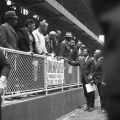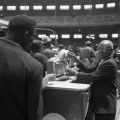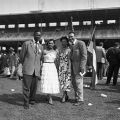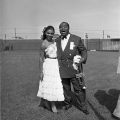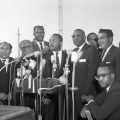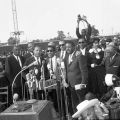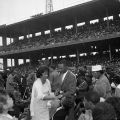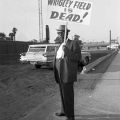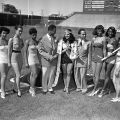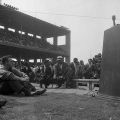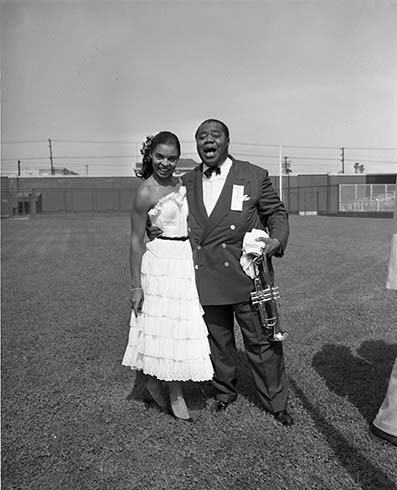 In 1921, William Mills Wrigley, Jr., the Wrigley Company founder of chewing gum and candy fame, became majority owner of Major League Baseball’s Chicago Cubs. That same year, a time when Major League Baseball had no teams west of St. Louis, Wrigley purchased the Pacific Coast League’s Los Angeles Angels, then a minor-league team. In 1925, he built a ballpark in L.A. for the Angels that he named Wrigley Field after himself. The park’s address was 425 E. 42nd Place in South-Central L.A., and its seating capacity was ~20,000. One year later, the Chicago Cubs renamed their home stadium, previously called Cubs Park, to Wrigley Field, as well.
In 1921, William Mills Wrigley, Jr., the Wrigley Company founder of chewing gum and candy fame, became majority owner of Major League Baseball’s Chicago Cubs. That same year, a time when Major League Baseball had no teams west of St. Louis, Wrigley purchased the Pacific Coast League’s Los Angeles Angels, then a minor-league team. In 1925, he built a ballpark in L.A. for the Angels that he named Wrigley Field after himself. The park’s address was 425 E. 42nd Place in South-Central L.A., and its seating capacity was ~20,000. One year later, the Chicago Cubs renamed their home stadium, previously called Cubs Park, to Wrigley Field, as well.
L.A.’s Wrigley Field hosted minor league baseball for over three decades, and was home to both the Angels and their Pacific Coast League rivals, the Hollywood Stars. In 1957, the National League’s Brooklyn Dodgers purchased Wrigley Field and the Angels franchise. The Dodgers relocated to L.A. in 1958. While the still-minor league Los Angeles Angels continued to play at L.A.’s Wrigley Field, the new Los Angeles Dodgers opted not to play there while Dodger Stadium was under construction in the Chavez Ravine. Instead, they played at the L.A. Coliseum while the city forcibly evicted predominantly Mexican American residents in the Ravine, bulldozing their homes to build Dodger Stadium despite fierce resistance efforts.
The Angels joined Major League Baseball in 1961. They played at L.A.’s Wrigley Field their first year in the league, but quickly abandoned the stadium, playing at the newly-built Dodger Stadium before permanently relocating to their own brand-new Anaheim stadium in 1966.
Beyond baseball, L.A.’s Wrigley Field was the setting for important non-sporting events for South-Central L.A. Three of them are documented online in the Tom and Ethel Bradley Center’s African American collections of Harry Adams and Charles Williams.
Leon Hefflin, Sr., an active community member and businessman, produced The Cavalcade of Jazz, a popular annual summer music festival, at the stadium throughout the 1940s and 1950s. He worked to bill interracial acts that would cater to diverse audiences. The Count Basie Orchestra and Big Joe Turner headlined the first festival in 1945, followed in subsequent years by such famous musicians as Nat King Cole, Little Richard, Louis Armstrong, The Sweethearts of Rhythm, Dizzy Gillespie, Little Miss Cornshucks, Dinah Washington, and Lionel Hampton. A Queen of the Cavalcade was crowned each year in the festival’s beauty pageant segment.
The Mass Rally for Freedom (or Freedom Rally) was held at Wrigley Field on May 26, 1963. According to the May 16th and May 30th issues of Los Angeles Sentinel, the goals of the civil rights rally were “to protest the atrocities in Birmingham, Ala., and of her southern cities and to raise funds to send to Birmingham to aid Dr. King and the Southern Christian Leadership Conference, in meeting the tremendous cost of bail for the thousands jailed and the court costs that will follow.” Several organizations, such as the Interdenominational Ministerial Alliance 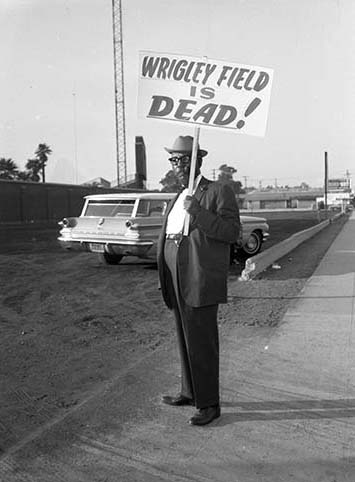 and the American Civil Liberties Union, and an estimated crowd of 30,000 to 40,000 gathered en masse for the rally and the parade held after. Prominent speakers Dr. Martin Luther King, Jr., Reverend Ralph Abernathy, Wyatt Walker, and Dick Gregory received a “Kingly tribute” and large gifts were donated by Sammy Davis, Jr., Nat King Cole, several Hollywood actors, and other residents, totaling around $75,000 after the rally and a fundraiser held at Burt Lancaster’s home.
and the American Civil Liberties Union, and an estimated crowd of 30,000 to 40,000 gathered en masse for the rally and the parade held after. Prominent speakers Dr. Martin Luther King, Jr., Reverend Ralph Abernathy, Wyatt Walker, and Dick Gregory received a “Kingly tribute” and large gifts were donated by Sammy Davis, Jr., Nat King Cole, several Hollywood actors, and other residents, totaling around $75,000 after the rally and a fundraiser held at Burt Lancaster’s home.
The Conference for the Unemployed was held at Wrigley Field on May 7, 1964, sponsored by Assemblyman Mervyn Dymally. According to the April 30th issue of Los Angeles Sentinel the goals of the conference were to spread information on job openings, training programs, and new assistance programs to assist the district’s 8,000+ unemployed as well as to publicly demonstrate and underscore the severity of the jobs crisis. Other event organizers included Congressman Augustus Hawkins and Los Angeles City Councilman Gilbert Lindsay.
In 1964, three years since the last baseball game was played at the stadium, talks of redevelopment intensified as it sat largely idle, underutilized and without baseball, although soccer had been introduced. The Wrigley Field Citizens Committee advocated revitalizing the area as a community center, specifically to address the district’s unemployment and healthcare needs. The stadium was demolished in 1969. Today, the Gilbert Lindsay Recreation Center and Kedren Community Health Center occupy the land, along with a much smaller baseball field named Wrigley Little League Field.




